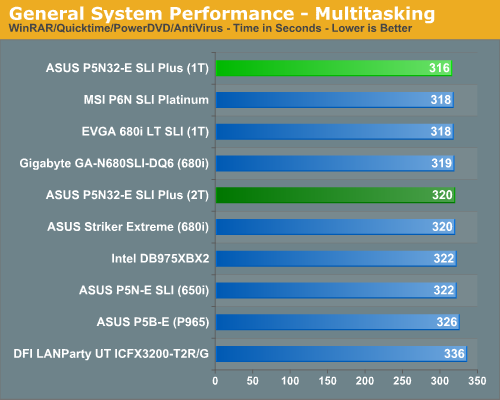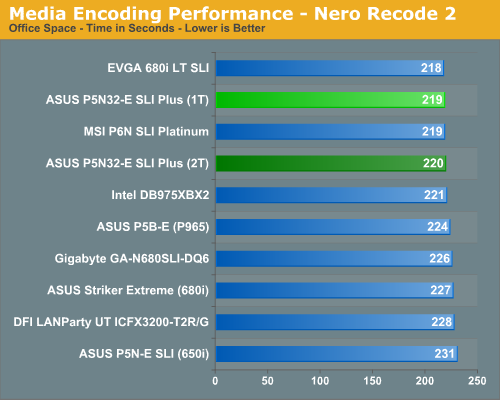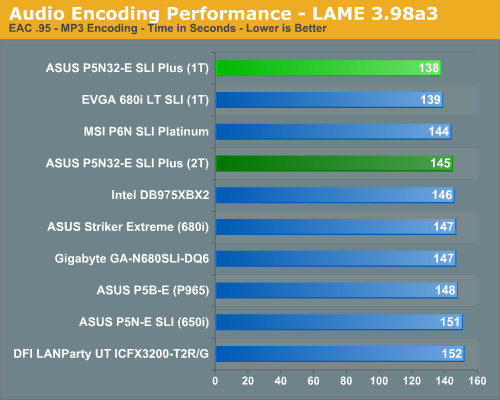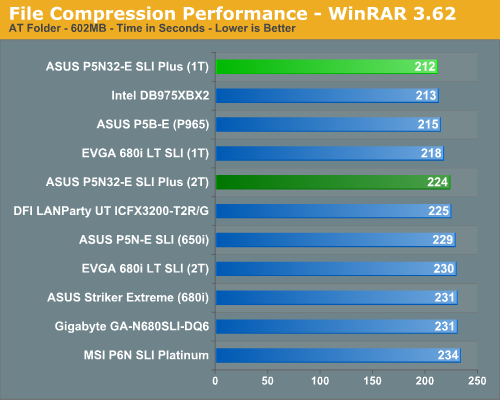ASUS P5N32-E SLI Plus: NVIDIA's 650i goes Dual x16
by Gary Key on April 2, 2007 3:30 AM EST- Posted in
- Motherboards
Multitasking Performance
We devised a script that would compress our standard test folder consisting of 444 files, ten subfolders, and 602MB worth of data, convert a 137MB High Definition QuickTime movie clip to a 37MB MPEG-4 format, play back the first two chapters of Office Space with PowerDVD, and run our AVG anti-virus program in the background. We stop the script when the file compression and video conversion are complete. This is a very taxing script for the CPU, Memory, and Storage subsystem. We also found it to be a good indicator of system stability during our overclocking testing.

The performance difference basically mirrors our PCMark 2005 tests with the ASUS, MSI, and EVGA boards finishing at the top due to great disk performance although the Intel boards consistently completed the QuickTime Conversion first. The DFI RD600 board scored last although it generated the best overall video playback results. Our differences in 1T and 2T timings in this test were minimal with WinRAR showing the only measurable benefits with our memory timings.
Media Encoding Performance
Our first encoding test is quite easy - we take our original Office Space DVD and use AnyDVD Ripper to copy the full DVD to the hard drive without compression, thus providing an almost exact duplicate of the DVD. We then fire up Nero Recode 2, select our Office Space copy on the hard drive, and perform a shrink operation to allow the entire movie along with extras to fit on a single 4.5GB DVD disc. We leave all options on their defaults except we turn off the advanced analysis option. The scores reported include the full encoding process and are represented in seconds, with lower numbers indicating better performance.

We continue to see a strong performance from the ASUS Plus board with the EVGA 680i LT SLI in our application tests finishing ever so slightly in front. We did not notice any differences in this test between 1T and 2T timings which surprised us as CPU throughput and disk access times are the critical factors affecting test scores. Media and Audio encoding are the few CPU centric tasks that NVIDIA chipsets handle well.
Audio Encoding Performance
While the media encoding prowess of the boards was superb in our initial media encoding testing, we wanted to see how they faired on the audio side. Our audio test suite consists of Exact Audio Copy v095.b4 and LAME 3.98a3. We utilize the INXS Greatest Hits CD that contains 16 tracks totaling 606MB of one time '80s hits. We set up EAC for variable bit rate encoding, burst mode for extraction, use external program for compression, and to start the external compressor upon extraction (EAC will read the next track while LAME is working on the previous track, thus removing a potential bottleneck with the optical drive). We also set the number of active threads to two to ensure both cores are active during testing. The results are presented in seconds for the encoding process, with lower numbers being better.

Our Plextor drive consistently took two minutes and nine seconds to read all sixteen tracks. This means our test systems are only utilizing one core during testing until the midway point of the extraction process where the drive speed begins exceeding the capability of the encoder and requires the use of a second thread.
As in the media encoding section, the more intensive CPU and storage system tests seem to favor the 975X over the P965/NV650i-680i/RD600 when running at the same memory timings. However, we are starting to notice a pattern in the latest NVIDIA releases where this is no longer the case, especially with 1T settings enabled on the NVIDIA chipset boards. This is especially true with the ASUS Plus board as we had a seven second difference between the two settings. We consider any results that differ greater than 5% to be noteworthy and depending upon the application, a difference that can be seen when using the systems on an every day basis.
We have almost completed the retesting all of our NVIDIA boards with 1T settings and will provide these results along with 2T timings in our next article if there are significant differences in performance. While the overall differences are minimal in the grand scheme of things, 1T performance can make a slight difference and is worth using if your RAM and motherboard can manage it.
File Compression Performance
In order to save space on our hard drives and ensure we had another CPU crunching utility, we will be reporting our file compression results with the latest version of WinRAR that fully supports multi-treaded operations and should be of particular interest for those users with dual core or multi-processor systems. Our series of file compression tests utilizes WinRAR 3.62 to compress our test folder that contains 444 files, ten subfolders, and 602MB worth of data. All default settings are utilized in WinRAR along with our hard drive being defragmented before each test.

We had stated in our EVGA 680i LT SLI article, "When you need pure CPU crunching power, the Intel chipsets win hands down." Well, today we have to eat some humble pie as the ASUS implementation of the 650i chipset is now holds the performance lead in this CPU crunching benchmark with 1T timings implemented. In fact we have an almost 6% performance difference in this benchmark between timings and to be quite honest, we thought the board was even faster than the benchmarks indicate.
We devised a script that would compress our standard test folder consisting of 444 files, ten subfolders, and 602MB worth of data, convert a 137MB High Definition QuickTime movie clip to a 37MB MPEG-4 format, play back the first two chapters of Office Space with PowerDVD, and run our AVG anti-virus program in the background. We stop the script when the file compression and video conversion are complete. This is a very taxing script for the CPU, Memory, and Storage subsystem. We also found it to be a good indicator of system stability during our overclocking testing.

The performance difference basically mirrors our PCMark 2005 tests with the ASUS, MSI, and EVGA boards finishing at the top due to great disk performance although the Intel boards consistently completed the QuickTime Conversion first. The DFI RD600 board scored last although it generated the best overall video playback results. Our differences in 1T and 2T timings in this test were minimal with WinRAR showing the only measurable benefits with our memory timings.
Media Encoding Performance
Our first encoding test is quite easy - we take our original Office Space DVD and use AnyDVD Ripper to copy the full DVD to the hard drive without compression, thus providing an almost exact duplicate of the DVD. We then fire up Nero Recode 2, select our Office Space copy on the hard drive, and perform a shrink operation to allow the entire movie along with extras to fit on a single 4.5GB DVD disc. We leave all options on their defaults except we turn off the advanced analysis option. The scores reported include the full encoding process and are represented in seconds, with lower numbers indicating better performance.

We continue to see a strong performance from the ASUS Plus board with the EVGA 680i LT SLI in our application tests finishing ever so slightly in front. We did not notice any differences in this test between 1T and 2T timings which surprised us as CPU throughput and disk access times are the critical factors affecting test scores. Media and Audio encoding are the few CPU centric tasks that NVIDIA chipsets handle well.
Audio Encoding Performance
While the media encoding prowess of the boards was superb in our initial media encoding testing, we wanted to see how they faired on the audio side. Our audio test suite consists of Exact Audio Copy v095.b4 and LAME 3.98a3. We utilize the INXS Greatest Hits CD that contains 16 tracks totaling 606MB of one time '80s hits. We set up EAC for variable bit rate encoding, burst mode for extraction, use external program for compression, and to start the external compressor upon extraction (EAC will read the next track while LAME is working on the previous track, thus removing a potential bottleneck with the optical drive). We also set the number of active threads to two to ensure both cores are active during testing. The results are presented in seconds for the encoding process, with lower numbers being better.

Our Plextor drive consistently took two minutes and nine seconds to read all sixteen tracks. This means our test systems are only utilizing one core during testing until the midway point of the extraction process where the drive speed begins exceeding the capability of the encoder and requires the use of a second thread.
As in the media encoding section, the more intensive CPU and storage system tests seem to favor the 975X over the P965/NV650i-680i/RD600 when running at the same memory timings. However, we are starting to notice a pattern in the latest NVIDIA releases where this is no longer the case, especially with 1T settings enabled on the NVIDIA chipset boards. This is especially true with the ASUS Plus board as we had a seven second difference between the two settings. We consider any results that differ greater than 5% to be noteworthy and depending upon the application, a difference that can be seen when using the systems on an every day basis.
We have almost completed the retesting all of our NVIDIA boards with 1T settings and will provide these results along with 2T timings in our next article if there are significant differences in performance. While the overall differences are minimal in the grand scheme of things, 1T performance can make a slight difference and is worth using if your RAM and motherboard can manage it.
File Compression Performance
In order to save space on our hard drives and ensure we had another CPU crunching utility, we will be reporting our file compression results with the latest version of WinRAR that fully supports multi-treaded operations and should be of particular interest for those users with dual core or multi-processor systems. Our series of file compression tests utilizes WinRAR 3.62 to compress our test folder that contains 444 files, ten subfolders, and 602MB worth of data. All default settings are utilized in WinRAR along with our hard drive being defragmented before each test.

We had stated in our EVGA 680i LT SLI article, "When you need pure CPU crunching power, the Intel chipsets win hands down." Well, today we have to eat some humble pie as the ASUS implementation of the 650i chipset is now holds the performance lead in this CPU crunching benchmark with 1T timings implemented. In fact we have an almost 6% performance difference in this benchmark between timings and to be quite honest, we thought the board was even faster than the benchmarks indicate.










37 Comments
View All Comments
yacoub - Sunday, April 29, 2007 - link
Just curious about the audio CPU usage test usually done on boards...Leinad - Tuesday, April 3, 2007 - link
In the FAQ for this board on the Asus website, the board is listed as a 680i board. Newegg lists it as a 650i board, and Anandtech likewise calls it a 650i board. Nice to finally see an explanation.Looking forward to the Motherboard roundup!
goinginstyle - Thursday, April 5, 2007 - link
Any chance of testing some cheap memory?sWORDs - Tuesday, April 3, 2007 - link
I'm really disappointed by this review, it's not up to the usual Anandtrch quality. Let me explain why:You can not call this a 650, because there is no nForce 430 southbridge.
Calling the southbridge a AMD570 is a bit misleading, because NB 570AMD = NB 590AMD = SB 590AMD = SB 590i = SB 680i.
Further more there might not even be a difference in the northbridge even if it has 8 lanes disabled, those aren't connected with the "real" 680i's either. They appear as a hidden link, the links on the Hybrid also have a missing #1 port, so it's there, not sure if it's cut or disabled. The only bord that appears to use it isn't here yet, it's the MSI Diamond with 4 PEG ports.
Besides this, you failed to notice that the pcb is actually a Striker Extreme (just peak under de Plus sticker). So any difference between this bord and a Striker Extreme are caused by difference of Bios, or between individual bords. You can't compare one Striker and one Plus and One Evga and make chipset conclussions, two Strikers might end up on different FSB speeds.
"680i SLI chipset utilizes the nForce 590 SLI MCP and 680i SLI MCP." That should be 680i SPP.
Memory timing differences should be caused by bios difference. THe Striker has a 1004 bios ready did you use that?
Dainas - Tuesday, April 3, 2007 - link
Great, so theirs only one PCI slot(rendered useless if you SLI) and the only PCIe 1x is rendered useless if you put a decent videocard in this machine.Not that any friggin SLI/Crossfire LGA board on the market can be considered much better should you want to have more than a soundcard installed.
sWORDs - Tuesday, April 3, 2007 - link
It has two PCI slots and only one would useless when using SLI with double sized cards. The only PCIe 1x is useless when using a double sized card.yacoub - Tuesday, April 3, 2007 - link
Btw this board gets some horrid reviews over on NewEgg. Sure, the user reviews there are known to be pretty tough because anytime someone has a bad experience they're ten times more likely to write about it than someone who has a good experience. But still, compare the reviews of this board with the reviews of the MSI board Anandtech reviewed last week.I wouldn't consider buying this Asus board seeing how many DOAs and other problems folks are reporting with it. The MSI, which doesn't overclock as well, seems much more likely to at least be a 100% functioning product.
How sad that the motherboard market has become this unreliable. I remember when Asus was a board you'd pay just a little more for because it would be solid.
kilkennycat - Monday, April 2, 2007 - link
.. 0501 has an extensive list of 23 fixes over 0402 !!The current latest is 0602 BETA.
See the Asus website. Make sure that you search for the PLUS version of the P5N32E-SLI.
Tuffrabbit - Monday, April 2, 2007 - link
It is interesting that the "budget" 650i board draws a whopping 47 more watts at idle than even the Flagship D975 Intel board ???Tuffrabbit - Monday, April 2, 2007 - link
Correction: Make that 57 watts...